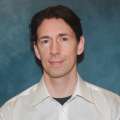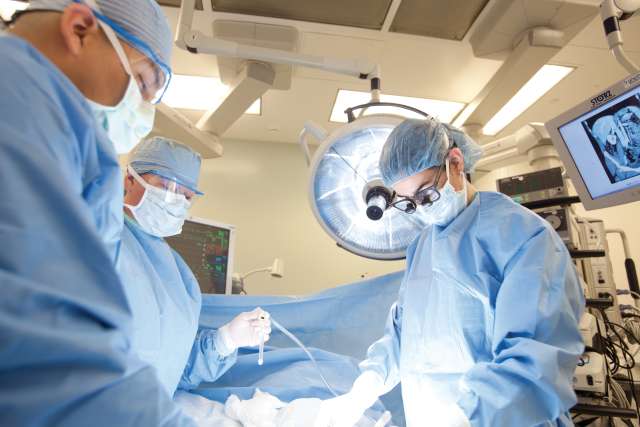Molecular screening in cancer research is kind of like playing the lottery. You just have to buy lots and lots of tickets. And be a little lucky.
In screening tens of thousands of compounds at once, the head of the at UCLA’s Jonsson Comprehensive Cancer Center is hoping to hit the jackpot—finding one that may be developed into a new, more effective and less toxic therapy to fight cancer.
As scientific director of the MSSR, Robert Damoiseaux plays a vital role in a process that begins in a laboratory with the development of cancer cell lines. Housed in the new California Nanosystems Institute, the state-of-the-art molecular screening facility—one of a handful nationwide—speeds a painstaking, manual process that once took years in laboratories into an automated, computer-run process that can take just days to complete.
The high-throughput technology—once available only to well-heeled pharmaceutical industry companies—is capable of screening as many as 100,000 compounds in a single day. It is available to Jonsson Cancer Center researchers, UCLA scientists and academic collaborators from around the world.
“The idea of high-throughput screening is to do a single experiment over and over and over again with the hope that in all the compounds you’re testing you find something that works,” Damoiseaux said. “The hallmark of cancer is that it grows, and fundamentally we’re interested in compounds that stop cells from proliferating so rapidly or stop them from growing at all.”
The compounds—small molecule drugs already approved by the U.S. Food & Drug Administration as well as purified natural products and fully synthetic molecules—are brought to UCLA from all over the world. Other compounds were developed at UCLA by chemists. The MSSR compound collection is constantly updated, Damoiseaux said. And although there is much thought and reasoning that goes into a screen, the process can be a lot like looking for the proverbial needle in the haystack.
“Typically, under one percent of the compounds tested are active on a first pass screen,” Damoiseaux said.
Fortunately, the first pass screen is not the last.
The process starts in a lab, with a Jonsson Cancer Center researcher developing cells lines for various types of cancer in Petri dishes, seeking to hit a known or unknown target on the cancer cell - a protein that is over-expressed and causing uncontrollable growth, a cell signaling pathway that is not operating correctly.
Targeting therapies to what is broken in a cancer cell, what causes it to grow or keeps it from dying, results in less toxic therapies. Unlike chemotherapy, which operates like a non-specific bomb hitting all fast growing cells in the body, targeted therapies generally leave the healthy cells alone and patients experience far fewer debilitating side effects. A handful of successful targeted therapies have been approved to fight cancer—Herceptin for breast cancer, Gleevec and Sprycel for chronic myeloid leukemia and Avastin for metastatic colorectal, breast, brain and kidney cancers, to name a few. Herceptin, Gleevec and Sprycel were all developed based on basic and clinical research done in Jonsson Cancer Center labs, while early pre-clinical testing on Avastin also was done at UCLA. That research was conducted without the benefit of high-throughput screening.
“Think of what we may be able to accomplish now,” Damoiseaux said, “using our automated equipment that is integrated into a single robotics system, technology that can work around-the-clock, 24 hours a day, seven days a week.”
Once a cancer cell line is developed, the researcher develops an assay, a procedure in molecular biology to test or measure the activity of a drug or biochemical compound in an organic sample, in this case cancer cells. Damoiseaux’s services are part of what the shared resources fees pay for. He consults extensively with the researchers to assure the cell lines are optimal for testing and the assays are designed for the best outcome. Then the compounds to be screened must be carefully selected.
“Since you don’t really know which compounds will work, you have to have a collection of all sorts of small molecules with different properties, ideally with low toxicities—a compound may be effective but highly dangerous to humans—the right size and polarities,” said Damoiseaux, who compiles the shared resource small molecule library. “Then we have to strategize about how to pick which compounds to screen first.”
He also has developed sub-libraries, kinases for example, to test against cancer cells. Kinases are unregulated in cancer and inhibitors to them have been successful at treating the disease.
Once the first collection of compounds has been selected, the cell line and assay system can be tested in a small trial run of about 1,500 compounds. The cells are loaded into plates with 384 wells each and the drugs are added. The plates are about the size of the palm of an adult hand. After the assay test is performed and success with a small library is achieved, up to 90,000 compounds are screened against the cell lines.
The robotic screening system is as big as a small walk-in closet and the air in the facility is HEPA filtered to protect the cell lines and compounds. The computerized, robotic system executes the screening process from start to finish, adding the compounds sitting in the tiny wells in the plates to the cancer cells, located in corresponding assay plates. A robotic arm with an automated liquid transfer system places a miniscule amount (about 4/10,000,000 of a quart) of the compound onto a plate containing the cancer cells and moves on to the next plate, cleaning and drying liquid transfer system components at regular intervals to insure purity. (VIDEO: .)
In 90 seconds the transfer of compounds onto cancer cells is completed and the cells go into an incubator, where they remain for about 48 hours. After 48 hours, a reagent is added that prompts a luminescent reaction, making the living cells light up. A plate reader then looks into each well and records how much signal or light is coming out—in other words, which cancer cells are alive and which have been killed.
Text files or spread sheets can be generated to analyze the data to determine which compounds are active. The automated system can retrieve all the compounds that appear to be active and put them into one 384-well plate for further screening.
The screen of the potentially active compounds is done again, with three different plates containing the same compounds.
“By repeating the screen three times, we know which compounds are really active,” Damoiseaux said. “There is a certain rate of false positives, so we do the screen multiple times to be sure.”
Once they have their “hits,” or active compounds, they study their chemical structure to see if they share similar properties. If a pattern emerges among the active compounds, other similar compounds can be purchased from libraries and added to the screen.
Armed with this new information, a sub-library of the hits is assembled and screened on different kinds of cells, cancerous, non-cancerous, metastatic cancer cells, to analyze what effect the compound has on different cell types. What may work on one type of breast cancer cell, for example, may not work on another. Like many other cancers, breast cancer is not one disease, but six or seven sub-types, each of which may react differently to small molecule compounds. The treatment, Damoiseaux explained, must be personalized to the patient for the most effective results.
Once the compounds that are the most active against the cancer cells and the least toxic to non-cancerous cells are identified, they can then be tested in animal models, and perhaps later in humans in clinical trials.
Fuyu Tamanoi, a professor of microbiology, immunology and molecular genetics and director of the cancer center’s Signal Transduction and Therapeutics Program Area, has used the high-throughput screening resource to search for small molecule inhibitors. An assay developed in his lab could test for inhibitors, but was not designed for high-throughput screening, he said. Damoiseaux and his team helped in adapting the assay for screening.
His assay was targeted against a gene product activated in pancreatic cancer and Damoiseaux was able to quickly screen 10,000 compounds using the resource. Tamanoi then screened for a different target in pancreatic cancer. While finding a compound to test as a drug to fight pancreatic cancer would have been optimal, the process revealed much to Tamanoi about what was going on within the cancer cells.
“It would not have been easy for us to develop a highthroughput assay without help from the shared resource,” Tamanoi said. “The hits we got through the screening have proven to be useful for further research and experimentation. It helped us validate hypotheses and has been very useful in figuring out where we want to go next. It helped us to know what pathways are talking to each other in this cancer and has aided us in writing grants for new funding.”
The Molecular Screening Shared Resource was developed five years ago and has been able to service more than 100 users.
As the technology advances, new capabilities are added to the screening resource. A newer technology employs automatic microscopy rather than a plate reader. Instead of adding a reagent and looking for a chemical reaction, individual cells are examined to determine how they are reacting to a compound.
“That gives you more information on the cellular level,” Damoiseaux said.
But with all the awe-inspiring technology at play, it’s the human factor that drives discovery.
“At the end of the day, what really makes this tick and tick fast is the scientists who come through the door and invest their time, energy and intellect into this,” Damoiseaux said. “They come to the MSSR with a system they know well. In contrast to many other screening facilities, we involve them as much as possible in the research process to get them the best results possible, which they can use to further their research.”





